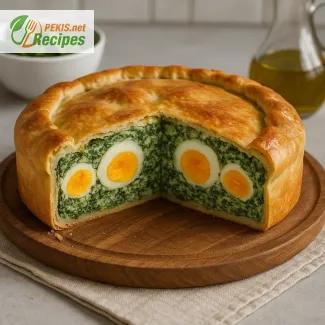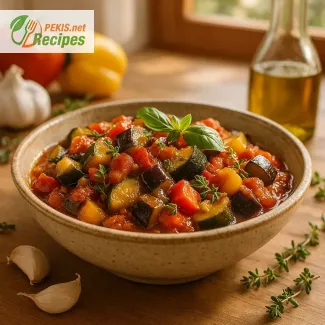
Discover the Timeless Elegance of Italy’s Easter Spinach and Ricotta Pie
A traditional Ligurian dish with a flaky crust and a rich, creamy filling
Every spring, as Easter celebrations unfold across Italy, tables are adorned with time-honored dishes that carry centuries of culinary heritage. Among them stands a true gem from the Ligurian region – the Torta Pasqualina, a rustic yet elegant savory pie filled with tender spinach, creamy ricotta cheese, and delicately nestled whole eggs. This Italian classic isn’t just food; it’s a symbol of rebirth, tradition, and family togetherness, often prepared during Holy Week and shared on Easter Sunday.
The Torta Pasqualina dates back to the 16th century, where it originated in Genoa, a coastal city known for its fresh produce and rich culinary traditions. Originally, this pie was crafted with an impressive 33 layers of dough, representing the years of Christ’s life. While modern versions are slightly simplified, the spirit of the dish remains intact—capturing the essence of spring produce, religious symbolism, and comforting home-cooked meals.
At the heart of every Torta Pasqualina lies a harmonious blend of earthy greens and creamy dairy. Traditionally, a variety of wild herbs known as erbette—including chard, spinach, and borage—are sautéed and folded into smooth ricotta, creating a rich, savory filling. The magic happens when whole raw eggs are carefully cracked into the filling before baking. As the pie bakes, the eggs cook gently inside, forming golden pockets of richness that contrast beautifully with the soft green filling and flaky pastry.
While it’s deeply rooted in Easter traditions, Torta Pasqualina can be enjoyed throughout spring and even into early summer. It’s the perfect dish for a festive brunch, a picnic centerpiece, or a make-ahead meal that only gets better the next day. Served warm or at room temperature, each slice tells a story of Italian culture and devotion to seasonal, quality ingredients.
What makes this dish particularly appealing is its versatility. Whether baked in a classic springform pan or crafted into individual hand pies, Torta Pasqualina adapts beautifully to different occasions. Vegetarians adore it for its depth of flavor, while its visual appeal—thanks to the golden egg yolks and layered greens—makes it a show-stopping addition to any celebration table.
The texture is another highlight: a light, flaky crust that gives way to a soft, cheesy interior. Some home cooks prefer using phyllo dough for a crispier bite, while others opt for traditional homemade pastry for a more rustic touch. Whichever route you take, the result is a pie that’s both comforting and sophisticated.
Cooking this dish at home is also a celebration of craftsmanship. Rolling out the thin layers of pastry, selecting the freshest greens, seasoning with a gentle touch of nutmeg, and cracking eggs into perfect little nests all turn the process into a culinary ritual. The aroma of baked cheese and greens wafting through the kitchen signals not just the arrival of a meal, but a moment of shared tradition.
For anyone exploring authentic Italian recipes, Torta Pasqualina is a must. It combines the soul of Mediterranean cooking with an artistry that only comes from generations of handed-down knowledge. It’s a dish made not just to satisfy hunger, but to celebrate life, renewal, and the richness of heritage.
In a world of fleeting food trends, Torta Pasqualina endures as a classic for a reason. With each bite, you taste the lush pastures of Liguria, the humble elegance of ricotta and spinach, and the joyful anticipation of Easter. Whether you're Italian by heritage or simply in heart, this savory pie invites you to be part of something timeless.
In the next sections, we’ll walk you through how to make Torta Pasqualina at home, including the exact ingredients, step-by-step preparation, and expert tips to ensure success. From the perfect dough to achieving that creamy, tender filling with golden egg centers, this is more than a recipe—it’s a journey into the heart of Italian home cooking.
- Prepare the dough: In a large mixing bowl, combine the flour and salt. Add the olive oil and water gradually while mixing until a soft dough forms. Knead on a floured surface for about 8–10 minutes until smooth and elastic. Divide into two balls (one slightly larger than the other), wrap in plastic, and let rest for 30 minutes at room temperature.
- Prepare the filling: Thoroughly wash the spinach and blanch in boiling water for 2–3 minutes. Drain well, squeeze out excess water, and finely chop. In a bowl, mix the chopped spinach with ricotta, grated Parmigiano, one beaten egg, nutmeg, salt, and pepper until you have a creamy, well-blended mixture.
- Roll the dough: Preheat the oven to 180°C (356°F). Roll out the larger dough ball into a thin round sheet (about 32–34 cm / 12.5–13.5 inches in diameter). Grease a 26 cm (10 inch) springform pan with butter and line it with the dough, allowing some overhang. Prick the base with a fork.
- Assemble the pie: Spread the spinach-ricotta mixture evenly into the dough-lined pan. Using the back of a spoon, create 4 small wells in the filling and carefully crack 4 whole eggs into each well. Optional: season each yolk lightly with salt and pepper.
- Top crust: Roll out the second dough ball into a slightly smaller round and place it over the filling. Fold the overhanging dough inward to seal the edges and pinch together. Prick the surface with a fork and optionally brush with a little olive oil.
- Bake: Place the torta in the preheated oven and bake for 45–50 minutes, or until the crust is golden and crisp. Let it rest in the pan for 10 minutes before unmolding. Serve warm or at room temperature.
Elevating the Classic Spinach and Ricotta Pie: Creative Twists on Torta Pasqualina
Smart upgrades, healthy swaps, and foolproof techniques for a perfect savory Easter pie
The beauty of Torta Pasqualina lies in its rustic simplicity, but even time-honored dishes can benefit from thoughtful refinement. Whether you want to enhance the flavor, boost the nutritional profile, or avoid common kitchen pitfalls, there are numerous ways to elevate this classic spinach and ricotta pie. From ingredient swaps to preparation techniques, these expert tips will help transform your Torta Pasqualina into a showstopping centerpiece for Easter—or any spring celebration.
Ingredient upgrades for deeper flavor and texture
While the traditional filling of spinach, ricotta, Parmigiano, and eggs offers a delightful balance of richness and freshness, small changes can yield big results in flavor and complexity.
Use a blend of greens
Instead of relying solely on spinach, try mixing in Swiss chard, kale, or even wild herbs like dandelion or sorrel. These greens add bitterness, earthiness, and vibrant color, enriching the pie’s flavor while staying true to the dish’s Ligurian roots.
Enhance the cheese profile
Ricotta provides creaminess, but for a deeper umami punch, add a small amount of Pecorino Romano or aged Asiago. Just 30–40 grams will give the filling a savory depth without overpowering the delicate greens.
Incorporate caramelized onions or leeks
Gently sautéed onions or leeks add a sweet, mellow base that balances the slight bitterness of the greens. This subtle addition can make the filling more layered and satisfying.
Add fresh herbs and spices
A sprinkle of fresh marjoram, thyme, or flat-leaf parsley can lift the entire dish with herbal brightness. Nutmeg is traditional, but a pinch of white pepper or lemon zest can add unexpected, delightful nuance.
Dough enhancements for a superior crust
The crust is more than a vessel—it’s an essential component that contributes texture and flavor.
Try olive oil shortcrust for added richness
If you're making dough from scratch, swap some of the water for extra virgin olive oil. This creates a crust that is not only flakier but also imparts a pleasant, slightly fruity undertone.
Use phyllo for a lighter version
For a crisp, delicate alternative, layer phyllo dough brushed with olive oil instead of traditional pastry. This method offers a crunchier bite and reduces the overall fat content.
Pre-bake the crust
To prevent sogginess, consider blind baking the base crust for 10 minutes before adding the filling. This ensures a firm bottom, especially important if your greens are very moist.
Why homemade is better
Making Torta Pasqualina at home allows for control over every element, from the quality of the ingredients to the seasoning and texture.
- Freshly made dough is more elastic and flavorful than store-bought alternatives.
- Home-prepped greens retain more nutrients and offer better texture than frozen varieties.
- You can adjust salt, cheese quantity, and egg doneness to your exact preference, something impossible with commercial versions.
Beyond flavor, preparing the pie yourself allows for cultural connection and culinary mindfulness, turning a meal into a meaningful experience.
Common mistakes to avoid
Even experienced cooks can make errors when working with this deceptively simple pie. Here's what to watch out for:
Not draining the greens properly
Excess moisture is the most common culprit of soggy pies. After blanching the spinach or chard, squeeze it thoroughly until almost dry. If your filling feels watery, add a tablespoon of breadcrumbs to absorb moisture.
Overbaking the eggs
When whole eggs are added to the filling, it's crucial to monitor the baking time carefully. Overcooked eggs can turn rubbery and unappetizing. Aim for firm whites and slightly soft yolks for the best contrast in texture.
Skipping the seasoning
Greens and ricotta are naturally mild. Without enough salt, pepper, and herbs, the filling can taste flat. Always taste your mixture (minus raw eggs) before assembling.
Uneven dough thickness
Rolling the dough too thick results in a doughy crust, while overly thin sheets may tear or leak. Aim for a uniform thickness of about 2–3 mm (1/10 inch) for best results.
Healthier alternatives that preserve tradition
Torta Pasqualina is already a nutritious dish, but there are ways to make it even healthier without sacrificing authenticity.
Low-fat ricotta and less cheese
Using low-fat ricotta reduces overall calories and saturated fat. You can also cut the Parmigiano quantity in half and still enjoy rich flavor by enhancing seasoning with herbs or spices.
Whole grain dough
Replace some of the white flour in the dough with whole wheat flour for more fiber, minerals, and a nutty flavor. Start with a 50/50 mix and adjust hydration as needed.
Egg whites instead of whole eggs
To reduce cholesterol, consider using egg whites in the filling and only one or two whole eggs for the center. This keeps the visual appeal of baked yolks without overloading on fat.
Gluten-free version
Use a gluten-free flour blend with xanthan gum to replicate the structure of traditional dough. While the texture may vary slightly, the taste remains true to the original.
Seasonal and regional variations to explore
Torta Pasqualina lends itself to endless adaptations based on what’s fresh and available.
- In summer, substitute spinach with zucchini or roasted red peppers.
- Add ricotta salata or feta for a brinier profile.
- In northern Italy, some versions include sautéed mushrooms or artichokes, offering earthy flavors and added texture.
These changes not only refresh the dish but also allow you to personalize it according to regional or dietary preferences.
Torta Pasqualina
The essence of Torta Pasqualina lies in balancing simplicity with skill. It’s a dish that welcomes creativity while honoring its roots. By carefully selecting your ingredients, refining your technique, and embracing seasonal variations, you can elevate this traditional pie into something truly unforgettable—whether for Easter or any occasion that calls for wholesome, satisfying food.
Allergens present in this recipe:
- Gluten (from all-purpose flour)
- Eggs
- Milk (ricotta and Parmigiano Reggiano)
Substitution tips for allergens and gluten:
- Gluten-free: Replace all-purpose flour with a gluten-free baking mix suitable for doughs. Add 1 tsp xanthan gum to help with elasticity.
- Dairy-free: Use dairy-free ricotta alternatives (such as almond-based ricotta) and replace Parmigiano Reggiano with nutritional yeast or vegan cheese.
- Egg-free: Omit whole eggs in the center; instead, increase ricotta quantity slightly. To mimic texture, use mashed silken tofu or chickpea flour "egg" in the filling.
- Vitamin A: 460 mcg – Supports vision and immune system
- Vitamin K: 320 mcg – Important for blood clotting and bone health
- Vitamin B12: 1.2 mcg – Essential for nerve function and red blood cell production
- Calcium: 280 mg – Maintains strong bones and teeth
- Iron: 3.1 mg – Supports oxygen transport in blood
- Magnesium: 60 mg – Regulates muscle and nerve function
- Folate: 120 mcg – Crucial for DNA synthesis and during pregnancy
- Lutein and Zeaxanthin (from spinach): 4 mg – Promote eye health and reduce risk of cataracts
- Beta-carotene (from spinach): 2.5 mg – Converts to vitamin A, protects cells from oxidative stress
- Selenium (from eggs and ricotta): 12 mcg – Supports immunity and thyroid health





